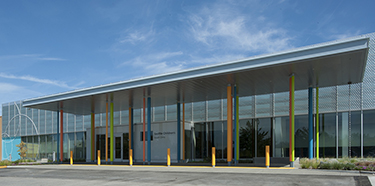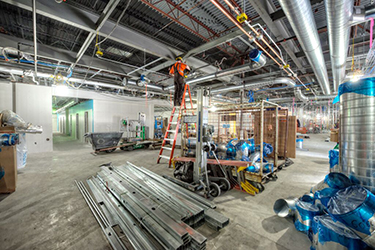|
Subscribe / Renew |
|
|
Contact Us |
|
| ► Subscribe to our Free Weekly Newsletter | |
| home | Welcome, sign in or click here to subscribe. | login |
Construction
| |
 |
July 23, 2015
Vacant big-box store finds new life as Children’s clinic
Aldrich + Associates

Ward
|
Health care real estate needs are changing as our local medical providers and hospitals seek to administer comprehensive care to patients in convenient retail locations. To address changing patient demographics and care preferences, the health care industry is shifting from centralized to decentralized care that delivers services closer to patients’ homes.
Today’s care model focuses on treating the whole patient while meeting their desires for whole-person preventive care and providing ready access to providers they need. As a result, fewer standalone health care campuses are needed as these clinics become integrated into local communities.
Retail clinics help meet a growing need for primary health care services. They will be an important delivery mechanism as health care providers seek to lower costs and handle the surge of newly insured patients with the implementation of the Affordable Care Act.
But these new clinics also need to be affordable. As local medical facilities seek reasonably priced real estate options, they are reaping the benefits of coincidence: In bringing community-based health care to communities, they are finding the opportunity to breathe new life into suburban retail cores by redeveloping some of the 5 million square feet of vacant retail infrastructures within the Seattle area.
Adaptive reuse
As retail spaces stand empty from overbuilding prior to the recession and an increase in online sales, high vacancies are generating new opportunities for health care tenants.
In particular, abandoned big-box stores are inspiring the reinvention of underperforming real estate as value adds to the surrounding community. Once destinations for convenience products, these converted facilities provide access to a range of health-oriented services.
In addition, this kind of adaptive reuse represents one of the country’s largest and quirkiest recycling efforts. From a sustainable development perspective, it is most often more efficient to modify an existing building than it is to construct a new building, even an energy-efficient or LEED-certified one.
A blank canvas
Where others saw an abandoned and neglected Circuit City building within Federal Way’s West Campus Square retail complex, Seattle Children’s Hospital, Aldrich + Associates, and ZGF Architects envisioned a modern facility aligned with the medical community’s demand for efficient medical space.
Todd Johnson, vice president of facilities at Seattle Children’s explained that the hospital was seeking both a blank canvas in a strategic location and an established community integrated with existing public transportation, highways, sidewalks, parking and urban utilities.
These kinds of reuse projects come with challenges and costs that are not normally present in a typical health care tenant improvement project. Electrical and water utility service upgrades were needed to meet the demands of equipment and plumbing fixtures. All-new HVAC equipment was installed to meet the increased zoning requirements.
But one of the biggest challenges to the team was working with the 25-foot high space between the floor and roof structure. The solution was to build an internal frame to support the HVAC, plumbing, electrical, low voltage and metal stud framing. This eliminated the thousands of man hours in lifts for trades installing long ceiling wires and seismic support to the structure above.
“Aldrich not only kept us on time and on budget,” Johnson said, “but their detailed mock-ups and simulations gave us the tools we needed to create a facility that will continue to be successful in Federal Way for years to come.”
A chance to stretch
Johnson said he believes the building will set a new standard for efficient, patient-centered health care facilities.
“The building was designed with flow in mind,” he said. “Our providers, nurses, and therapists need to operate efficiently in the space. If we do it right, and I think we did, we can see more patients and offer higher-quality care. We are making an investment in the community, and we believe that this will inevitably increase patient satisfaction.”
The city of Federal Way was a supportive partner throughout the project.
“From the start, the city helped us evaluate the site, meet regulations, and assisted in navigating the permitting process,” said Taka Soga, principal and project manager at ZGF.
“Architects always want to create a project from the ground up, but this reuse project offered us the opportunity to stretch our creative minds and find solutions that we may not have considered before,” Soga said.
As the popularity of decentralized, comprehensive and convenient health care grows within our retail communities, adaptive reuse may prove to be an industry trend that shapes the future of health care.
George Ward is vice president of Aldrich + Associates, a general contractor specializing in the construction of sophisticated health care and institutional projects in the Pacific Northwest for over 40 years.
Other Stories:
- Hospital addition zeroes in on better patient care
- High-tech lights can aid patients by mimicking the effects of nature
- What we’ve learned about making hospitals better for seniors
- It’s never too early to consider tech in your nursing home project
- New clinic at Swedish will treat patients who suffer from chronic pain
- Whidbey hospital’s hyper-efficient HVAC system may be the first of its kind here
- How a pharmacy was designed to limit exposure to toxic drugs
- The way we design health care projects is changing in a big way
- Hospice brings comfort to dying patients




